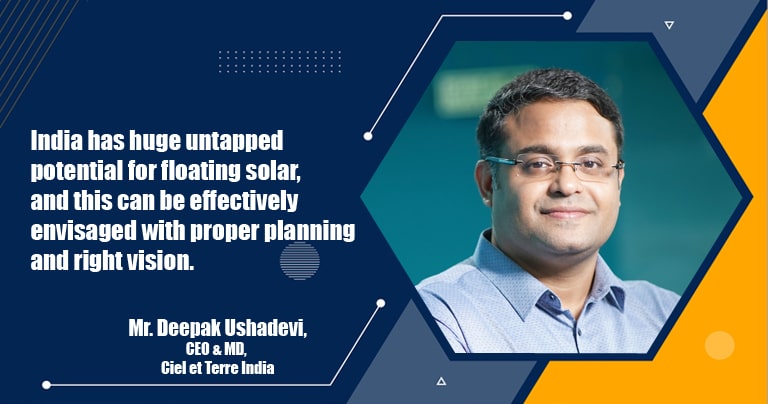Investments in assets is key to enhance design and technology for floating solar
By EPR Magazine Editorial November 26, 2021 6:33 pm IST
By EPR Magazine Editorial November 26, 2021 6:33 pm IST

Discussing the opportunities and challenges for the Floating Solar PV in India, Deepak Ushadevi, CEO & MD, Ciel & Terre India emphasises the need for increased investments to create new assets and technologies in the Floating Solar PV segment.
How are the present energy trends impacting the demand for FPV in India?
The Indian subcontinent has a huge scope for floating solar as it has varied and diverse water bodies that are suitable for installing floating solar plants. As the 2nd most populated country, we face a constantly growing land and energy need. With available, unused water bodies, we can convert them into energy and money generating sources with the help of floating solar. FSPV (Floating Solar PV) is gaining a lot of traction recently with its economic, environmental, and social benefits.
FSPVs are land neutral, reduce water evaporation, reduce algal growth, produce higher energy due to lower temperature coefficients, less O&M costs, ease of implementation and hybrid power generation with Hydel power systems. With all these advantages, FSPV can change the current dynamics of the Renewable energy sector.
Now with the country facing a shortage of coal and a blackout threat looming around, floating solar turns out to be the perfect solution. It is right to say that floating solar is the third pillar of the Solar PV sector.
What are the opportunities and challenges for FPV?
India is currently witnessing a growing energy need, with scarcity in the land, legal issues in land acquisition, disputes, infinite acquisition delays, and ground-mount/roof-mounted solar are becoming challenging in recent times, the floating solar is the apt solution. We consider India will be the biggest market for floating solar worldwide and therefore we are investing in new assets to provide our latest designs on a large scale. Adding to that, the Indian government has set an ambitious target of 10 GW floating solar installation by the year 2022.
The primary challenge is that the floating solar projects must be sustainable for 25 years. Unlike ground mount, floating solar must keep the fundamental techniques intact. Each site should have unique designs depending on the topography of the area. The variation in the water level and the undercurrent of the water also poses challenges, especially when it comes to anchoring and moving the floating platforms.
Quality is paramount to protect the asset for 25 years at least. Ciel et Terre collaborates with many leading expertise for wind resistance, Wave and current resistance, mechanical resistance, floatability, UV resistance, Drinking water compliance, Temperature resistance. Ciel et Terre international has collaboration with Principia, a leading offshore player to implement & integrate wind and wave design with cost-effective solutions.
How floating solar projects different in terms of installation and maintenance?The installation is different and requires experienced engineers and technicians. The expertise of floating array load, distribution and buoyancy are very crucial to implement and any wrongdoing during installation will be a disaster in the making.
One must visualise the site conditions. The use of appropriate tools, understanding the use of different make materials for each specific site very much essential while during installation. We are aware of the quality issues of other players, the mandate for us to develop quality projects in India.
Another aspect is on the O&M part. The cost is cheaper than a ground-mounted system, as there is less soiling due to the water around, plenty of water availability for cleaning. Conventional brush cleaning would be reducing the O&M expenses. During engineering design suite creation, moisture prevention of electrical equipment should be tended to and all our equipment are water-resistant and withstand even a moisture friendly environment.
How do you contribute to India’s Make in India vision?
Ciel et Terre India has its very own manufacturing unit in Kerala further contributing to India’s Make in India and Made in India mission. Presently, we have 5 manufacturing units in India with a capacity of 300 MWp annual production.
With the global energy sector going green, what kind of technologically advanced structures/modules do you offer to this sector?
Human activities are already overloaded with CO2 and other global warming emissions, and this is a global issue. Floating solar would allow us to replace carbon-intensive energy resources and will significantly reduce global warming emissions and silently contribute to the reliability and resilience of clean/green energy revolution.
The material used to manufacture the floats and all supplementary materials used are made of HDPE, which is recyclable. The primary motto behind the product itself is to produce green energy without disturbing the environment. Unlike ground/ roof mount solar, FPV does not demand the removal of trees to install the project. We believe that the world can run on green energy without disturbing the natural ecosystem. India has huge untapped potential for floating solar, and this can be effectively envisaged with proper planning and the right vision. I wish to see more renewable projects realised with more and more Hydrelio solutions across the globe as well.
We use cookies to personalize your experience. By continuing to visit this website you agree to our Terms & Conditions, Privacy Policy and Cookie Policy.